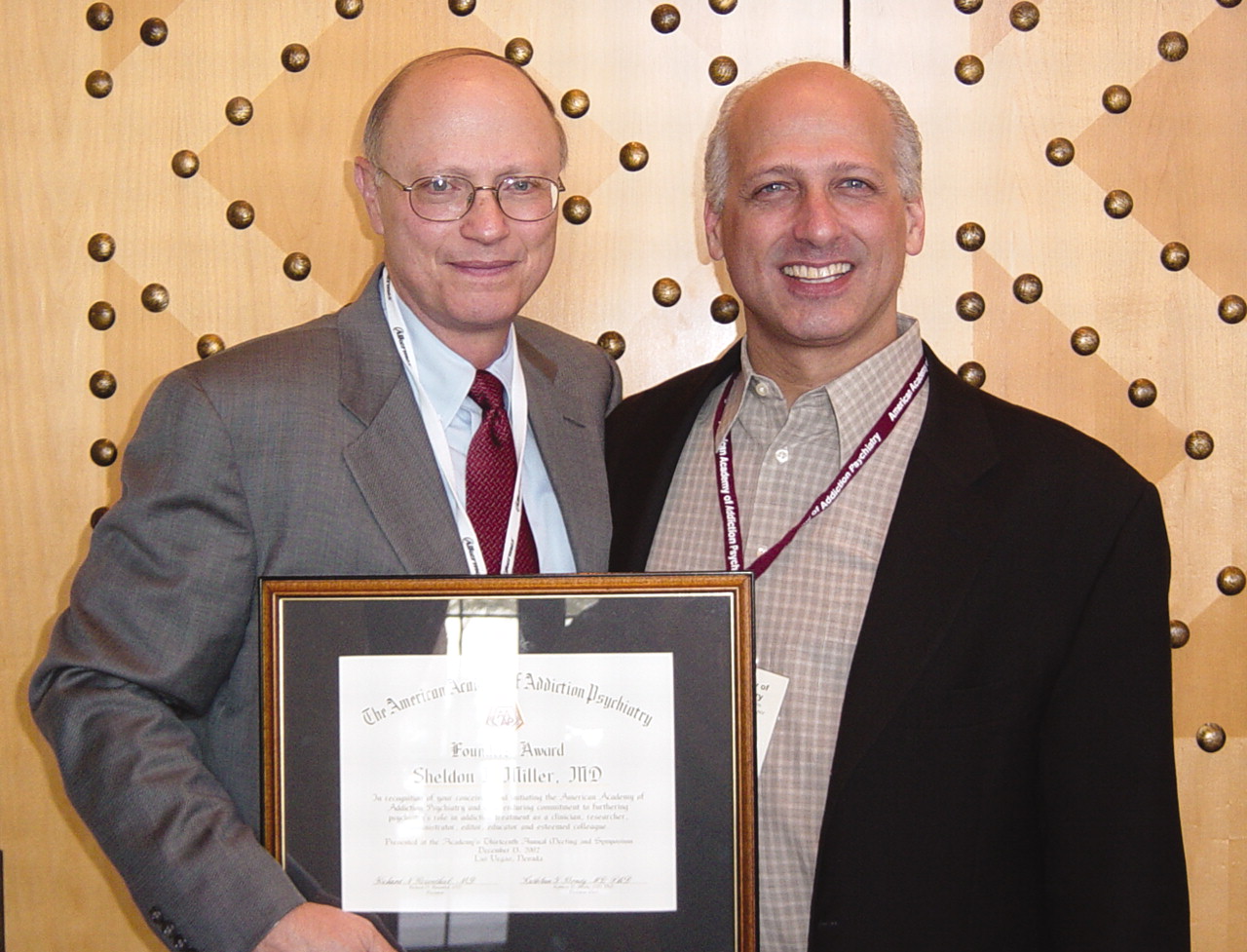In recognition of his “conceiving and initiating the American Academy of Addiction Psychiatry (AAAP) and enduring role in addiction treatment as a clinician, researcher, administrator, editor, educator, and esteemed colleague,” academy President Richard Rosenthal, M.D., presented the AAAP 2002 Founders’ Award to Sheldon I. Miller. M.D., at last month’s AAAP annual meeting in Las Vegas.
“It is amazing, just truly incredible, how far [addiction psychiatry] has come in such a short time,” Miller said. During his lecture, Miller took a quick stroll down memory lane, detailing 30 years of history—from his admittedly personal perspective—including the founding of AAAP and the recognition of addiction psychiatry as a formal subspecialty by the American Board of Psychiatry and Neurology (ABPN).
As a resident in the 1960s, Miller recalled, “the only thing about my training regarding addiction that was consistent was that there wasn’t any.” Indeed, the prevailing thought at the time was to focus not on the addiction as a primary disorder, but on the underlying disease causing the addiction. Direct treatment of addiction did not exist.
“In fact,” he told about 320 attendees, “my course on psychopharmacology was only one hour long. And we had plenty of time for discussion.”
Subspecialty Gets Born
After residency, Miller headed west, to the Navajo Reservation as a member of the Public Health Service. There, Miller said, he encountered 11- to 14-year-old adolescents dying of cirrhosis in a society with a high rate of alcohol abuse. The only tools he had at the time were Antibuse (disulfuram) and 12-step programs—clearly not sufficient options in a Native-American society, he said.
“I left there frustrated, interested, and determined to see whether we could move this field farther than we were,” Miller recalled. “It was also clear to me that what I had been taught was wrong—not just problematic, but wrong. The only thing was, I didn’t know what was right. And that really is where all of this [the AAAP] started.”
The field of addiction medicine has experienced tremendous growth since then, Miller said. It has explored learning theory, experienced the controlled-drinking movement, “and now we’re coming into an age where we are beginning to understand the genetics and the biological roots of this disorder. We are understanding how behavioral interacts with biological.”
The concept of dual diagnosis is now a given, Miller said. “When I began in this field, if you raised that point, you would probably have been stoned by the audience you were speaking to.”
The transition between the two extremes occurred over many years, with significant work to found the AAAP as a formal, cohesive voice for addiction psychiatry, pushing the point that mental illness and addiction could not be separated. It was also a battle, both scientifically and politically, to gain acceptance as a formal subspecialty recognized for certification by ABPN, Miller recounted.
Volunteerism Missing
Miller spent the bulk of his lecture talking about a topic that he said rarely comes up in addiction psychiatry: volunteerism.
After returning to the faculty at Case Western Reserve School of Medicine in the early 1970s, Miller said, he became involved with the National Council on Alcoholism, which at the time represented “a very strong, serious movement.” The organization included “people from all walks of life, many of whom were recovering.” Miller said he had the pleasure of working with the council chapter at Case Western Reserve, but then the council receded and has not regained its former strength.
“And that is very sad, and we need to think about that,” Miller told those attending the meeting. “We compare ourselves, based on the frequency with which our illness occurs, with other organizations, the heart people, the cancer people, et cetera. And we wonder from time to time why those folks have mainstreamed it.”
These organizations have become public and effective at lobbying Congress. While, for example, the stigma of cancer over the years has disappeared, the stigma of addiction, while diminished, is still “very much present,” he observed.
“One of the issues in our field,” Miller emphasized, “is the absence of a strong, vibrant, and vocal volunteer movement. Without it, it is going to be very difficult for us as professionals to carry the torch alone. We need our patients with us, and we don’t have them right now—not visibly, not vocally, and not even near as much as the rest of mental health has been able to put together.”
Without that volunteer movement, Miller contemplated, addiction psychiatry will not be able to move forward and mainstream addiction as an illness and addiction medicine as a mainstream treatment.
Research funding in addiction has been “absolutely fantastic,” Miller noted. “But it hasn’t changed public policy, and it hasn’t changed the public’s attitude or that of the business community.”
Miller concluded, “I really believe that if we are to have the potential, and we are to grow and move forward from where we are, we have to make sure we have evidence behind our treatments. Opinion and theory no longer sell well any more. Evidence is selling.
“It is critical that this organization grows,” he emphasized. “It’s critical to further the care of our patients, in order to get what we want, and frankly, in order to further your own careers.”
With growth, the AAAP will become more powerful, “and if we can someday ally ourselves with, as mental health generally has, the voluntary and volunteerism sector, I think we have a wonderful future.” ▪

